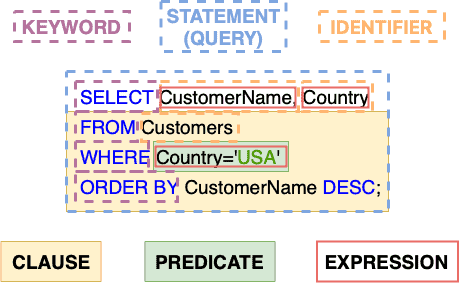Learn through the super-clean Baeldung Pro experience:
>> Membership and Baeldung Pro.
No ads, dark-mode and 6 months free of IntelliJ Idea Ultimate to start with.
Last updated: April 16, 2024
Structured Query Language (SQL) is a standard programming language widely used for managing and manipulating relational databases. It includes various elements, such as queries, statements, clauses, expressions, and predicates, each serving a specific function in database management.
In this tutorial, we’ll start by introducing all the elements in SQL. Then, we’ll concentrate on two of these elements: SQL queries and statements. Lastly, we’ll explore their distinctions and give useful examples for each.
SQL is a declarative language, meaning we tell it what we want, and it figures out how to do it. It includes a variety of elements to construct commands. There are seven key elements in SQL:
The figure below illustrates the key elements of SQL:

The terms SQL statement and SQL query are sometimes used interchangeably, but there are key differences between them. Let’s explore what they are.
An SQL statement is a command issued to the database for performing various tasks such as retrieving data, updating records, or manipulating the database structure.
SQL statements include queries (commands for retrieving data) and encompass a wider set of operations, such as:
Each of these statements helps users interact and manipulate the data and the structure of the database in different ways, making SQL a flexible and powerful language for managing relational databases.
Let’s look at an example INSERT statement:
INSERT INTO Customers (CustomerName, ContactName, Country)
VALUES ('Cardinal', 'Tom B. Erichsen', 'Norway');
In this example, the INSERT statement adds a new row of data to the Customers table.
SQL queries are a subset of SQL statements that return data based on specific criteria. They’re used specifically to retrieve data from the database, and they do this using the SELECT statement. Let’s see a simple SQL query using the SELECT statement:
SELECT CustomerName, Country
FROM Customers
WHERE Country='USA';
This query returns the names and countries of all customers from the Customers table located in the USA.
In essence, all queries are statements, but not all statements are queries. A query is a statement that retrieves data, while statements can do this and much more, including modifying data and altering the database structure.
In this article, we talked about the elements of SQL, including keywords, identifiers, expressions, queries, statements, clauses, and predicates. It’s common to use the terms statements and queries interchangeably. However, they do have distinct meanings and serve different purposes. Understanding the distinction between SQL statements and queries is essential for anyone working with SQL.
A query is a statement that specifically retrieves data and helps clarify their unique roles within the SQL language using the SELECT operation. On the other hand, statements include a broader set of operations, such as INSERT, UPDATE, DELETE, CREATE, ALTER, and DROP.